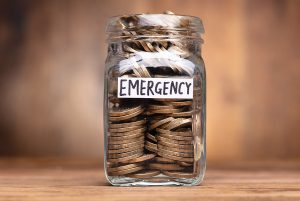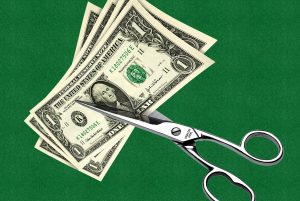Here are seven ways to build your money confidence — and your wealth — right now
Build a Better Budget
For more than a quarter of Americans, setting up a budget feels more painful than getting their teeth pulled, according to a new survey by conducted by Jayhawk Media, a media company that produces personal finance content. Perhaps that’s why 47% of Americans don’t have a budget of any kind in place. But not having a budget could cause problems that are much worse than a toothache, warns personal finance expert John Egan, Jayhawk’s owner.
“Some people avoid budgeting because they make it way too complicated,” Egan says. But setting up a budget can be as simple as tracking your monthly income and expenses in a dedicated notebook. Getting a handle on those numbers can help guide your monthly spending and savings.
Once you’ve got the basics down, step up your budget game by downloading a budgeting app like Mint, Egan advises. (See below “There’s an App for That!”) Or you can use any number of budget spreadsheet templates that are available online. The bottom line? “No matter which budgeting method you choose, it’s important to closely monitor your monthly income and expenses to help future-proof your finances,” Egan says. Ultimately, your goal is simple: save more than you spend.
Once you’ve set your budget, you should routinely track how you’re doing. “Do a budget close-out of each month,” suggests Ariel Lim, a personal finance consultant. Did you spend what you projected? Was there more income than expected? “Don’t be too quick to spend ‘extra’ income without first balancing your budget,” Lim advises. Otherwise you may not be able to take advantage of an opportunity later.
Have a Revenue Target

Most people think of only their expenses when it comes to budgeting, but looking at it from another perspective can help a lot, says Galit Tsadik, money expert and founder of Financial Sharktress, a personal finance website. She recommends that those who earn money through commissions set a monthly target for how much they plan to earn. “For example, my monthly revenue target is 2x my expenses — meaning, if it hit my goal, I have already covered my fixed monthly obligations and still have extra money to do what I want,” Tsadik says. “In most cases,
I funnel this into investment opportunities.”
Plan for Inconsistent Months

If your income fluctuates, make a plan for months when you earn more than expected, suggests Frankie Fegurgur, who teaches financial literacy at www.frankmoneytalk.com. “My goal would be to first learn what your financial goals are and then determine how much of the additional money you want to put toward your financial goals,” he says.
A second task would be to determine how much of the additional income (for those months where you make extra money) you want to add to that goal fund. “If you typically earn $3,000, you might feel you need most of it to live on,” he says, “but you may be willing to set aside $100 per month toward your goals.” On the other hand, “If one month you make $4,500, do you increase to $1,600 per month or do you want to experience a little bonus spending spree for your extra hard work? That’s what you need to decide.”
Another strategy: Consider figuring out your average income and having a separate bank account to help even out your cashflow, suggests Penelope Jane Smith, a financial coach. On months where you exceed your average income, put the extra in this account.
Establish an Emergency Fund

Build a fund specifically for emergencies, like a spouse losing a job, advises Lim. “This isn’t a new tip, but you’d be amazed at how many people don’t take this seriously.” Indeed, the Jayhawk survey revealed that the average American’s emergency fund totals just $2,299 — which won’t be likely to cover a significant emergency. Ideally, an emergency fund should cover all of your necessary living expenses for three to six months. “For me, having a six-month runway is what helps me stay calm and be able to sleep at night,” she says.
Of course, “It’s easy to talk the talk when it comes to an emergency fund, but if you haven’t actually fleshed out your emergency savings account, there’s no better time to start,” advises Sean Messier, associate editor of Credit Card Insider. “Anytime you have even a little bit of cash to spare after covering your essential expenses and your usual savings, funnel some money into another savings account that you’re explicitly saving for when it’s absolutely necessary.” Don’t get discouraged: Setting aside even a small amount of money each week or month adds up.
Be Strategic About Credit Card Use

Racking up too much in credit card interest fees? You don’t actually have to pay interest on a credit card if you use it carefully, Messier says. “By default, most credit cards have grace periods that extend from the date your statement is generated to your payment due date. This means that if you make a purchase toward the beginning of your month-long billing period, you can pay off that purchase over a span of nearly two months, since you’ll have the rest of the billing period and the grace period to cover the cost before you’re charged interest.
“Aim to whittle your balance down to zero by the time your payment due date comes to a close, or else you’ll be charged interest on whatever remains,” he advises.
If you’re not certain you’ll be able to pay off certain essential purchases in a reasonable amount of time, consider a 0% purchase APR credit card. These cards allow you to make purchases at 0% interest for a set period of time that often exceeds a year. Just make sure you have a plan to pay its balance in full by the time that period ends.
Trim Monthly Expenses

It’s a good practice to routinely scour your expenses and see if there are items you can cut out completely, suggests Lim. “I have a budget app that I’ve been using for years,” she says. “Last March, when clients started cancelling their projects left and right, I immediately opened the app, searched for recurring expenses and unsubscribed to everything I didn’t need, like Spotify and Netflix. Don’t continue to incur expenses for things you don’t use.”
If you’re looking to trim monthly expenses, now is a good time to call your cell phone and insurance providers to see if you can save money. Do you really need that big data plan? Look into cheaper data plans offered by your provider and compare them to deals from other providers.
To avoid tapping her traditional savings account for special expenses, like holiday gifts, Lim also creates a sinking fund (a savings account that you deposit money in regularly and can only be used for a set purpose) to better track expenses. One best practice is to create the fund over a lengthy period: If you know, for example, that you want to save a certain amount for holiday expenses, you would divide that total cost by the number of months you have remaining, and then save each month to meet that goal.
Don’t Check Your Investments Every Day

“Uncertainty can cause anxiety, and right now we are seeing much uncertainty in the economy,” says Tsadik. “With reports of the stock market fluctuating, it is easy to get caught up in those anxious feelings, but it’s important to take a step back and breathe. Do not check your investments every day. Let them ride.” Also, don’t try to “play” the market, Tsadik advises. “The more and more you try to time the market to get better results, the more often you end up losing money. Remember, markets return to health over the long term.”
Her last piece of advice: Stay calm. “Many people are anxious about managing money, but our energy plays a big role in our well-being in all aspects of life,” she says. “Keeping a positive mindset will help you properly manage your money — and your sanity.”
As more Americans work to improve how they save, budget and invest, the tech world has come to the rescue with a stream of apps to lend a hand. Here are three helpful options. Many of these tools are free, and all are available on iOS and Android devices
If you want to save more and reduce spending
Try: Mint
Often considered the gold standard for budgeting tools, this app provides a comprehensive collection of simple tools for tracking your spending, budgeting and goals. It automatically updates and categorizes transactions, creating a picture of spending in real-time. Users can add their own categories, split transactions and set budgets that alert them when they’re exceeding their maximum spending. Another bonus: The app checks your credit score for free.
If you want to keep things simple
Try: PocketGuard
Many people who use budgeting apps only want to know one thing: how much money they have to spend. This app crunches the numbers to reveal how much money is available after accounting for your monthly expenses, spending and saving goals contributions. Users can see how much money is “left in my pocket” for any given period. It’s also easy to see how much you’re spending in a given category, like groceries or clothing.
If you want to optimize your investment strategy
Try: Personal Capital
This tool, available on both your desktop and phone, can help you monitor all of your financial accounts — from certificate of deposit accounts to retirement funds — in real-time. It combines the algorithms used by robo-advisors with access to human financial advisors to offer objective investment advice and provide options that are tailored to your goals. While primarily an investment tool, the free version also helps you monitor checking, savings and credit card accounts, as well as IRAs, 401(k)s, mortgages and loans.
© Rolffimages; Syda Productions; DoubletreeStudio; Pixel-Shot; Andrey Popov; Feodora; Henry Bonn; Fizkes


